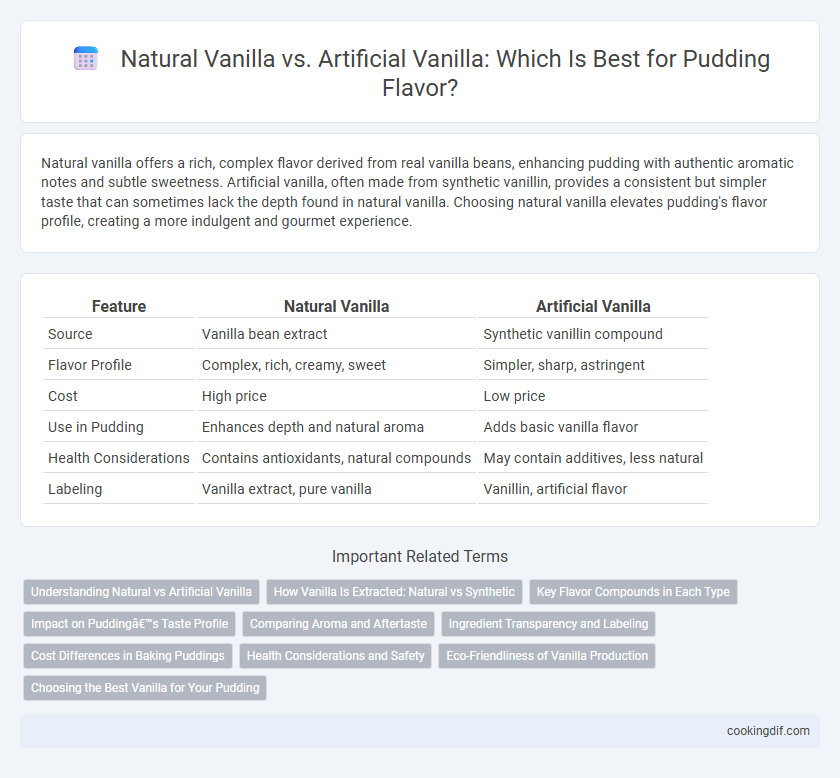Natural vanilla offers a rich, complex flavor derived from real vanilla beans, enhancing pudding with authentic aromatic notes and subtle sweetness. Artificial vanilla, often made from synthetic vanillin, provides a consistent but simpler taste that can sometimes lack the depth found in natural vanilla. Choosing natural vanilla elevates pudding's flavor profile, creating a more indulgent and gourmet experience.
Table of Comparison
| Feature | Natural Vanilla | Artificial Vanilla |
|---|---|---|
| Source | Vanilla bean extract | Synthetic vanillin compound |
| Flavor Profile | Complex, rich, creamy, sweet | Simpler, sharp, astringent |
| Cost | High price | Low price |
| Use in Pudding | Enhances depth and natural aroma | Adds basic vanilla flavor |
| Health Considerations | Contains antioxidants, natural compounds | May contain additives, less natural |
| Labeling | Vanilla extract, pure vanilla | Vanillin, artificial flavor |
Understanding Natural vs Artificial Vanilla
Natural vanilla contains complex compounds such as vanillin alongside hundreds of flavorful molecules that provide a rich, aromatic profile ideal for pudding. Artificial vanilla primarily relies on synthetic vanillin, offering a consistent but simpler flavor that lacks the depth and subtlety found in natural extracts. Understanding these differences helps in selecting the right type for pudding recipes, balancing cost, flavor authenticity, and ingredient sourcing.
How Vanilla Is Extracted: Natural vs Synthetic
Natural vanilla is extracted from the cured pods of the Vanilla planifolia orchid through a lengthy process involving drying and alcohol-based extraction, resulting in complex flavor compounds like vanillin and hundreds of minor aromatic elements. Artificial vanilla, primarily composed of synthetic vanillin, is chemically derived from lignin or guaiacol, offering a consistent but simpler flavor profile. The extraction method directly impacts the depth and authenticity of vanilla flavor in pudding, with natural vanilla providing a richer, more nuanced taste compared to the one-dimensional aroma of artificial variants.
Key Flavor Compounds in Each Type
Natural vanilla contains key flavor compounds such as vanillin, p-hydroxybenzaldehyde, and vanillic acid, which provide a complex, rich aroma and taste profile. Artificial vanilla primarily relies on synthetic vanillin, lacking the subtle nuances found in natural extracts. The presence of additional phenolic and aromatic compounds in natural vanilla enhances pudding flavor depth compared to the singular note of artificial vanilla.
Impact on Pudding’s Taste Profile
Natural vanilla enhances pudding's taste profile with rich, complex flavors derived from real vanilla beans, delivering aromatic notes and a creamy depth that artificial vanilla cannot replicate. Artificial vanilla contains synthetic vanillin, which provides a singular, sharp sweetness but lacks the subtle nuances that contribute to a layered and authentic vanilla experience in pudding. Choosing natural vanilla significantly elevates pudding flavor by providing smoother, more balanced, and aromatic qualities that improve overall sensory enjoyment.
Comparing Aroma and Aftertaste
Natural vanilla offers a rich, complex aroma with warm, floral notes and a subtle sweetness that enhances pudding's depth of flavor. Artificial vanilla tends to have a sharper, more one-dimensional scent, often lacking the nuanced complexity of natural extracts. The aftertaste of natural vanilla remains smooth and lingering, while artificial vanilla can leave a slightly chemical or synthetic residue on the palate.
Ingredient Transparency and Labeling
Natural vanilla is derived from vanilla bean extracts, offering authentic flavor compounds clearly listed on ingredient labels, ensuring ingredient transparency for consumers. Artificial vanilla, typically made from synthetic vanillin, may appear as "vanillin" or "artificial flavor" on packaging, often obscuring the source and raising concerns about ingredient clarity. Clear labeling of natural versus artificial vanilla is crucial for consumers seeking transparency and quality in pudding ingredients.
Cost Differences in Baking Puddings
Natural vanilla, derived from vanilla bean extract, commands a significantly higher price due to the labor-intensive cultivation and extraction processes. Artificial vanilla, or vanillin, is produced synthetically at a fraction of the cost, making it a popular choice for cost-effective pudding recipes. When baking puddings, using natural vanilla can increase ingredient expenses by up to 500%, while artificial vanilla provides a budget-friendly alternative with a similar vanilla flavor profile.
Health Considerations and Safety
Natural vanilla contains antioxidants and trace nutrients beneficial to health, while artificial vanilla, primarily made from synthetic vanillin, lacks these natural compounds and may pose allergy risks for sensitive individuals. Studies indicate natural vanilla extract has fewer harmful contaminants compared to some artificial vanillin products that can contain ethyl vanillin or other synthetics linked to toxic effects in high doses. Choosing natural vanilla for pudding flavor reduces exposure to chemically produced additives, supporting safer consumption and better overall health outcomes.
Eco-Friendliness of Vanilla Production
Natural vanilla production involves labor-intensive cultivation and harvesting of vanilla orchids, which often supports biodiversity but requires considerable land and water resources. Artificial vanilla, primarily made from synthetic vanillin, has a lower environmental footprint due to factory-based production with reduced land use and resource consumption. Choosing natural vanilla supports sustainable farming practices but may result in higher ecological costs compared to the more eco-efficient synthetic alternative.
Choosing the Best Vanilla for Your Pudding
Natural vanilla provides a rich, complex flavor profile derived from real vanilla beans, enhancing the creamy texture and aroma of pudding with subtle floral and sweet notes. Artificial vanilla, or vanillin, offers a consistent and cost-effective option but lacks the depth and nuance found in natural extracts. For the best pudding flavor, prioritize pure vanilla extract or vanilla bean paste to achieve authentic taste and superior quality.
Natural vanilla vs Artificial vanilla for flavor Infographic

 cookingdif.com
cookingdif.com